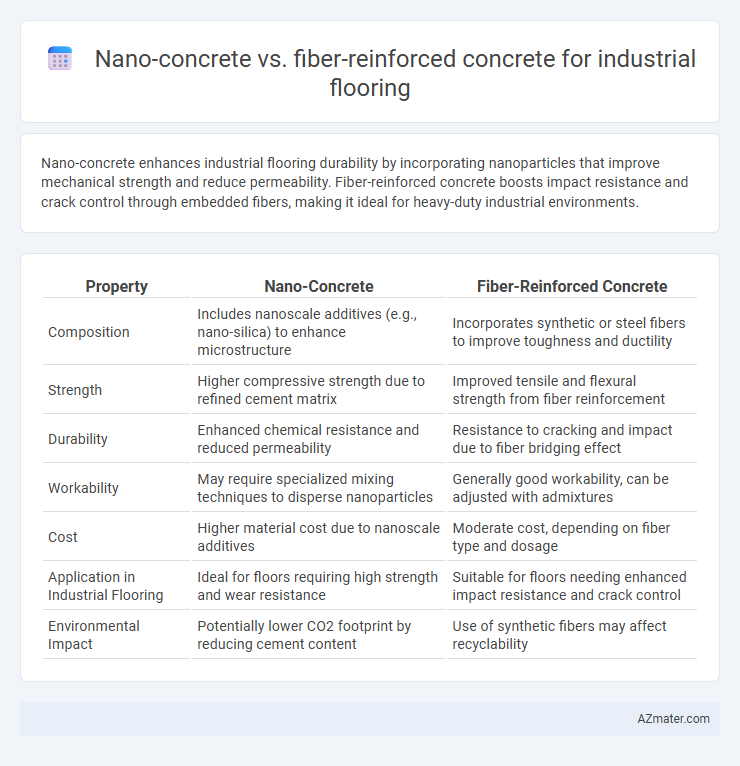Nano-concrete enhances industrial flooring durability by incorporating nanoparticles that improve mechanical strength and reduce permeability. Fiber-reinforced concrete boosts impact resistance and crack control through embedded fibers, making it ideal for heavy-duty industrial environments.
Table of Comparison
| Property | Nano-Concrete | Fiber-Reinforced Concrete |
|---|---|---|
| Composition | Includes nanoscale additives (e.g., nano-silica) to enhance microstructure | Incorporates synthetic or steel fibers to improve toughness and ductility |
| Strength | Higher compressive strength due to refined cement matrix | Improved tensile and flexural strength from fiber reinforcement |
| Durability | Enhanced chemical resistance and reduced permeability | Resistance to cracking and impact due to fiber bridging effect |
| Workability | May require specialized mixing techniques to disperse nanoparticles | Generally good workability, can be adjusted with admixtures |
| Cost | Higher material cost due to nanoscale additives | Moderate cost, depending on fiber type and dosage |
| Application in Industrial Flooring | Ideal for floors requiring high strength and wear resistance | Suitable for floors needing enhanced impact resistance and crack control |
| Environmental Impact | Potentially lower CO2 footprint by reducing cement content | Use of synthetic fibers may affect recyclability |
Introduction to Industrial Flooring Solutions
Nano-concrete enhances industrial flooring by incorporating nanoparticles that improve compressive strength, durability, and resistance to chemical attacks, making it ideal for heavy-duty applications. Fiber-reinforced concrete integrates synthetic or steel fibers to provide superior tensile strength, crack resistance, and impact absorption, extending the lifespan of floors in high-traffic industrial environments. Both materials optimize performance, with nano-concrete excelling in molecular-level enhancement and fiber-reinforced concrete offering macro-level reinforcement for industrial flooring solutions.
What is Nano-Concrete?
Nano-concrete incorporates nanoparticles like silica, titanium dioxide, and carbon nanotubes to enhance the microstructure of the concrete matrix, improving strength and durability for industrial flooring applications. This technology results in a denser, more impermeable surface that resists wear, chemical attacks, and mechanical stresses better than conventional fiber-reinforced concrete. Nano-concrete's advanced properties make it ideal for heavy-duty flooring environments requiring high performance and longevity.
What is Fiber-Reinforced Concrete?
Fiber-reinforced concrete (FRC) incorporates discrete fibers such as steel, glass, or synthetic materials to enhance tensile strength, reduce cracking, and improve durability for industrial flooring applications. Unlike nano-concrete, which utilizes nanoscale additives to modify the concrete's microstructure for increased strength and impermeability, FRC directly addresses crack control and impact resistance through its fiber mesh. The integration of fibers in concrete provides superior toughness and load distribution, making it ideal for heavy-duty industrial floors exposed to dynamic and mechanical stresses.
Comparative Strength and Durability
Nano-concrete exhibits superior compressive strength and enhanced durability due to its reduced porosity and improved microstructure, making it highly resistant to chemical attacks and abrasion in industrial flooring applications. Fiber-reinforced concrete offers improved tensile strength and crack resistance by incorporating steel or synthetic fibers, which enhance impact resistance and flexural toughness but may have slightly lower compressive strength compared to nano-modified mixes. Industrial floors subjected to heavy loads benefit from nano-concrete's longevity and shrinkage control, while fiber-reinforced concrete excels in resisting dynamic stresses and preventing crack propagation.
Crack Resistance and Structural Integrity
Nano-concrete exhibits superior crack resistance due to its enhanced nanoparticle distribution that fills micro-pores, resulting in a denser matrix ideal for industrial flooring applications. Fiber-reinforced concrete improves structural integrity by integrating synthetic or steel fibers that effectively bridge cracks and distribute stresses across the slab. Both materials contribute significantly to prolonging industrial floor lifespan, with nano-concrete optimizing durability on a microstructural level while fiber-reinforced concrete enhances toughness and impact resistance.
Installation Process and Practical Considerations
Nano-concrete offers a rapid installation process due to its enhanced flowability and early strength development, reducing downtime in industrial flooring projects. Fiber-reinforced concrete requires careful mixing and placement to ensure uniform fiber distribution, which can extend installation time but improves crack resistance and durability. Practical considerations include the need for precise dosing and specialized equipment for nano-concrete, whereas fiber-reinforced concrete demands attention to fiber type and dosage to optimize mechanical performance in heavy-duty industrial environments.
Cost Analysis: Nano-Concrete vs Fiber-Reinforced Concrete
Nano-concrete typically incurs higher material costs due to the incorporation of nanoscale additives like nan silica and carbon nanotubes, which enhance strength and durability but increase price. Fiber-reinforced concrete generally offers a more cost-effective solution with moderate improvement in tensile strength and crack resistance using polypropylene, steel, or glass fibers. Industrial flooring projects favor fiber-reinforced concrete when budget constraints exist, while nano-concrete is preferred for long-term performance despite the initial higher investment.
Long-term Maintenance and Lifecycle Performance
Nano-concrete enhances industrial flooring durability by improving microstructure density, reducing permeability, and minimizing cracking, which significantly lowers long-term maintenance costs. Fiber-reinforced concrete offers superior tensile strength and impact resistance, extending service life by mitigating damage from heavy machinery and dynamic loads across the lifecycle. Both materials contribute to prolonged flooring performance, but nano-concrete excels in chemical resistance and shrinkage control, while fiber-reinforced concrete enhances structural integrity under mechanical stress.
Environmental Impact and Sustainability Factors
Nano-concrete enhances industrial flooring sustainability by incorporating nanoparticles that improve durability and reduce material consumption, leading to lower carbon emissions compared to traditional mixes. Fiber-reinforced concrete increases toughness and crack resistance, minimizing repair frequency and thus lowering environmental impact from maintenance activities. Both materials contribute to extending service life, but nano-concrete's ability to optimize microstructure provides a more significant reduction in resource usage and waste generation.
Choosing the Best Concrete Technology for Industrial Flooring
Nano-concrete incorporates nano-sized particles that enhance the material's strength, durability, and resistance to chemical attacks, making it ideal for heavy industrial flooring subjected to harsh environments. Fiber-reinforced concrete integrates synthetic or steel fibers that improve tensile strength, reduce cracking, and increase toughness, providing excellent performance under heavy mechanical loads and impact conditions. Selecting the best technology depends on specific application requirements such as load type, exposure conditions, and long-term durability needs, with nano-concrete excelling in chemical resistance and fiber-reinforced concrete offering superior crack control and resilience.

Infographic: Nano-concrete vs Fiber-reinforced concrete for Industrial flooring
 azmater.com
azmater.com